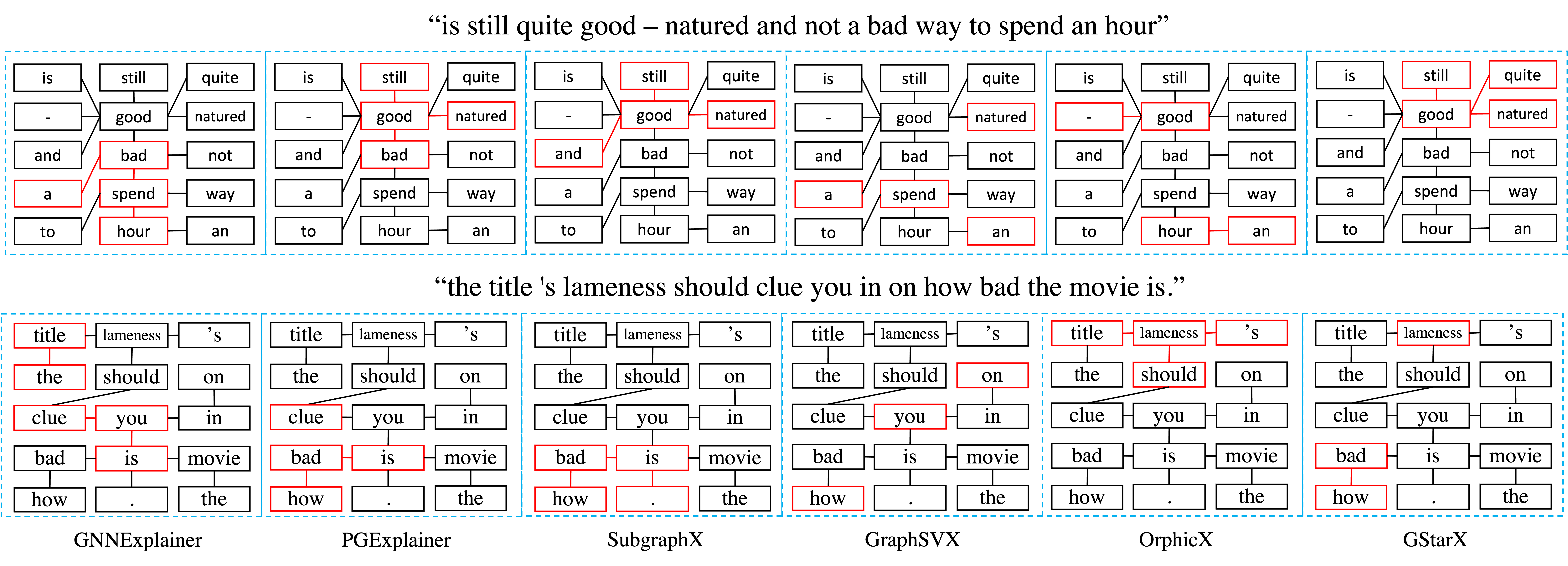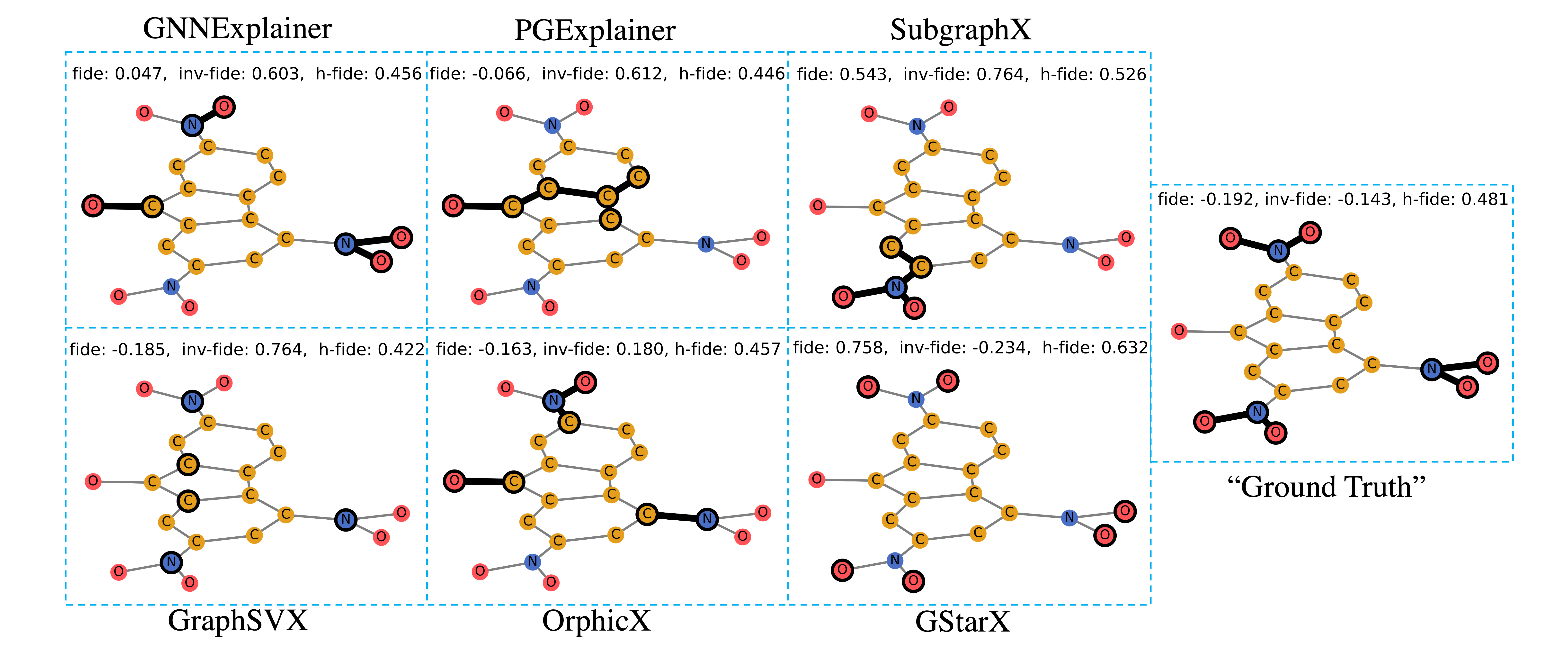Graph Structure-aware Explanation (GStarX)
Code for Explaining Graph Neural Networks with Structure-Aware Cooperative Games by Shichang Zhang, Yozen Liu, Neil Shah, and Yizhou Sun.
Visualizations
Explanation on the graph-sst2 dataset
GStarX concisely captures the important words for sentiment classification without including extraneous ones for either the positive sentence or the negative sentence.
Explanation on the mutag dataset
GStarX generates explanations with much better Fidelity/Inv-Fidelity/H-Fidelity than other methods and even better than the “ground truth” specified by the domain knowledge.
Getting Started
Requirements
-
Please follow the links below to install PyTorch and PyG with proper CUDA versions
-
Then install packages by running the line below
pip install -r requirements.txt- Our code has been tested with
- Python = 3.8.10
- PyTorch = 1.10.0
- PyG = 1.7.2
Datasets
To run experiments for datasets used in the paper, please download them from this link and put them under datasets/ (all dataset folder names should be in lowercase, some of them need to be renamed. Please be consistent with dataset.py).
You may also add your favourite datasets by modifying the get_dataset function in dataset.py.
Models
We borrow the GCN, GIN, and GAT implementation and the model training script train_gnns.py from the DIG library. Pre-trained checkpoints of these models are stored in checkpoints/
Usage
- Run the GStarX to explain trained GNN models
- A simple example is shown below, and more examples are in
script.sh
- A simple example is shown below, and more examples are in
python run_gstarx.py models='gcn' datasets='mutag'- Run a baslineline method to explain trained GNN models
- Run baseline scripts like the example below by replacing
methodwithgnn_explainer,pgexplainer,subgraphx,graphsvx, ororphicx.
- Run baseline scripts like the example below by replacing
python baselines/run_${method}.py models='gcn' datasets='bace'- Train new GNNs to explain
- If not GCN, GIN, or GAT, add the model architecture to
getNets.py, and add its configuration toconfig - Run
train_gnns.pyas the example below
- If not GCN, GIN, or GAT, add the model architecture to
python train_gnns.py datasets=ba_2motifs models=gatResults
GStarX vs. other methods for graph prediction explanation in terms of the H-Fidelity metric. GStarX outperforms others on most datasets, on average, and on different GNN architectures. (Please see Table 1 and Table 2 in the paper).
| Datasets | GNNExplainer | PGExplainer | SubgraphX | GraphSVX | OrphicX | GStarX |
|---|---|---|---|---|---|---|
| BA_2Motifs (GCN) | 0.4841 | 0.4879 | 0.6050 | 0.5017 | 0.5087 | 0.5824 |
| BACE (GCN) | 0.5016 | 0.5127 | 0.5519 | 0.5067 | 0.4960 | 0.5934 |
| BBBP (GCN) | 0.4735 | 0.4750 | 0.5610 | 0.5345 | 0.4893 | 0.5227 |
| GraphSST2 (GCN) | 0.4845 | 0.5196 | 0.5487 | 0.5053 | 0.4924 | 0.5519 |
| MUTAG (GCN) | 0.4745 | 0.4714 | 0.5253 | 0.5211 | 0.4925 | 0.6171 |
| Twitter (GCN) | 0.4838 | 0.4938 | 0.5494 | 0.4989 | 0.4944 | 0.5716 |
| Average (GCN) | 0.4837 | 0.4934 | 0.5569 | 0.5114 | 0.4952 | 0.5732 |
| Datasets | GNNExplainer | PGExplainer | SubgraphX | GraphSVX | OrphicX | GStarX |
|---|---|---|---|---|---|---|
| GraphSST2 (GAT) | 0.4951 | 0.4918 | 0.5484 | 0.5132 | 0.4997 | 0.5542 |
| MUTAG (GIN) | 0.5042 | 0.4993 | 0.5264 | 0.5592 | 0.5152 | 0.6064 |
Cite
Please cite our paper if you find this code is useful. Thank you.
@misc{zhang2022explaining,
title={Explaining Graph-level Predictions with Communication Structure-Aware Cooperative Games},
author={Shichang Zhang and Neil Shah and Yozen Liu and Yizhou Sun},
year={2022},
eprint={2201.12380},
archivePrefix={arXiv},
primaryClass={cs.LG}
}
Reference
Our code heavily relies on the DIG library. We encourage readers to check it out:
https://github.com/divelab/DIG/tree/dig/benchmarks/xgraph
Contact Us
Please open an issue or contact shichang@cs.ucla.edu if you have any questions.

